(Upload on September 1 2025) [ 日本語 | English ]
Mount Usu / Sarobetsu post-mined peatland
From left: Crater basin in 1986 and 2006. Cottongrass / Daylily
HOME > Lecture catalog / Research summary > Glossary > Wood
[ wood physics | wood chemistry | forest science | tree ]
Wood:the secondary xylem in the stems of trees (s.s.)the secondary xylem and the same type of tissue elsewhere such as in the roots of trees or shrubs (s.l.) Wood science (木材科学)the interdisciplinary study of wood as a natural, bio-based material—its structure, properties, and applicationsCore areas
|
|
|
The area of wood science concerned with the physical and mechanical properties of wood and the factors which affect them.
bridging biology, chemistry, physics, engineering, etc. Wood density (木材密度)= wood specific gravity= the dry weight per unit volume of wood
specific gravity = oven dry weight/fresh volume indicating fire tolerance The heaviest wood density is reported from Krugiodendron ferreum (black ironwood) of which density is 1.3 g/cm³ → sinking Table. Representative wood densities (as a guide). The density is fluctuated due to location, water content, part, etc. -: not determined.Species = Wood density (g/cm³) Abies sachalinensis (トドマツ) = 0.42 maples (Acer amoenum (オオモミジ), A. japonicum (ハウチワカエデ), A. mono (エゾイタヤ), A. negundo (ネグンドカエデ) ≈ 0.67 Betula platyphylla (シラカンバ) = 0.64 Castanea crenata (クリ) = 0.60-0.68 Cercidiphyllum japonicum (カツラ) = 0.45 Ginkgo biloba (イチョウ) = 0.55 Picea jezoensis (キハダ) = 0.45 Picea jezoensis (エゾマツ) = 0.48 Pinus nigra (オウシュウクロマツ) = 0.48 Populus nigra (セイヨウハコヤナギ / ポプラ) = 0.45 Prunus sargentii (エゾヤマザクラ) = 0.63 Quercus mongolica (ミズナラ) = 0.68 Quercus rubra (アカナラ) = 0.54 Robinia pseudoacacia (ニセアカシア) = 0.75 Sorbus commixta (ナナカマド) = 0.71 |
Taxus cuspidata (イチイ) = 0.48 Tilia japonica (シナノキ) = 0.44 Tilia maximowicziana (オオバボダイジュ) = 0.43 Ulmus davidiana (ハルニレ) = 0.59 The table is used for estimating CO2 fixing in trees in a field trip, Nature in the eco-campus of Hokkaido Universit (北大エコキャンパスの自然)
Forest type and location
n
SR
Gravity 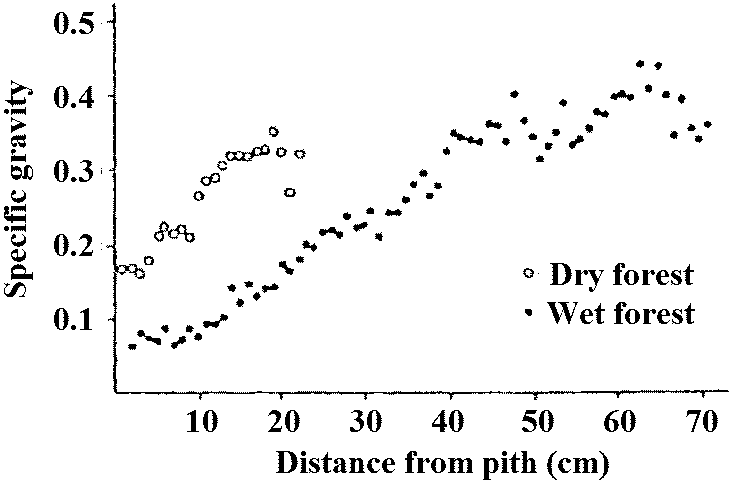 Fig. Specific gravity as a function of distance from pith for Ceiba pentandra from a tropical dry forest and a tropical wet forest.
Fig. Specific gravity as a function of distance from pith for Ceiba pentandra from a tropical dry forest and a tropical wet forest.
|
Standardization (標準化)1. general standardization (一般的標準化)2. removing growth trend (成長傾向除去) 3. conceptual linear aggregate model (for tree-rings) Rt = At + Ct + D1t + D2t + Et
Rt = the measured tree-ring series Dendrochronology (年輪年代学)= tree-ring dating ⇒ dendroclimatologycrossdating by COFECHA in dplR library (Bunn 2010) Table 1 Subfield of dendrochronology (Speer 2012).Dendroarchaeology (年輪考古学)Tree-ring samples from beams and posts in archaeological dwellings are dated to provide construction dates for the dwellings. The position of these beams in the dwelling can be used to study the timing of construction and expansion of dwellings and to start to understand human behavior in these cultures. Correlation with regional master chronologies can also help to dendro-provenance archaeological and historical wood object. |
[ climatology ] Dendroclimatology (年輪気候学)Because trees are an important functional feature of many ecosystems, they can be used as a natural record of ecological processes, such as tree-line movement, successional processes through the establishment and death of trees, fire occurrence (Dendropyrochronology), insect outbreaks, (Dendroentomology), synchronous fruiting (masting) in trees (Dendromastecology), or movement of invasive tree species.[ geography ] Dendrogeomorphology (年輪地形学)The vertical structure of a tree enables it to gather the most light while standing up straight so that land movement can be reconstructed by the tilting of a tree and the resultant reaction wood (thicker growth rings produced to straighten the stem of a tree). Also tree death or establishment can be used to date geologic phenomena such as landslides, mudflows, seismic activity along faults (Dendroseismology), glacial activity (Dendroglaciology), or volcanic events (Dendrovolcanology).Dendrochemistry (年輪化学)Trees absorb chemicals along with the water that they absorb from soil and the gases that they take in from the atmosphere. These chemicals are deposited in the wood in the trees’ stem, roots, and branches and can be used as a record of contamination, nutrient availability, and pollution. Stable isotopes can also be measured in wood structure to reconstruct past temperature, humidity, and the source of water or growing conditions of the trees. |
|
= log processing, timber processing Def. raw wood, log,timber log or unprocessed log (原木): wood that has not undergone any finishing, painting or processing Def. (wood) grain (木目): the longitudinal arrangement of wood fibers or the pattern that results from this arrangement
determined by the growth rings and cellular structure + _ 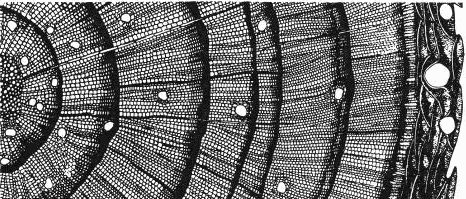 _┬______└ earlywood ─┘┬└annual ring______│_______┬ └ bark ┘ _pith__○ resin duct__latewood__________false ring__cambium Fig. Pine crosssection. Conifer trees in temperate areas produce one ring per year. These rings can be broken into the earlywood portion (open cells with thin cell walls) and the latewood portion (cells with thick cell walls and a smaller lumen). Other features that are present are the pith, resin ducts, cambium, and the bark. The variation in ring width is generally driven by climate and results in the pattern of wide and narrow rings that we use to cross date the wood samples. Sometimes a false ring may be present, as in this sample, where the tree growth slows because of a reduction in the limiting factor for growth of the tree, such as drought. When that environmental factor limiting growth returns (e.g. when it rains), the tree resumes growth and the cells grade back to earlywood structure with thinner cell walls. |
Classification of wood based on vessel arrangement
Ulmus davidiana Ex. Magnolia obovata, Betula platyphylla, Acer mono, Aesculus turbinata Radial-porous wood (放射孔材)Wood tissue

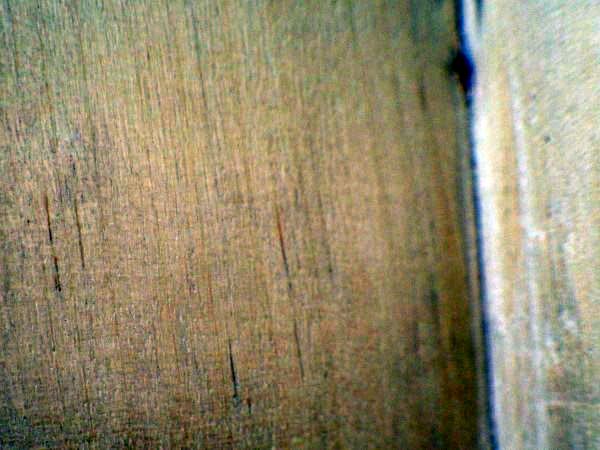
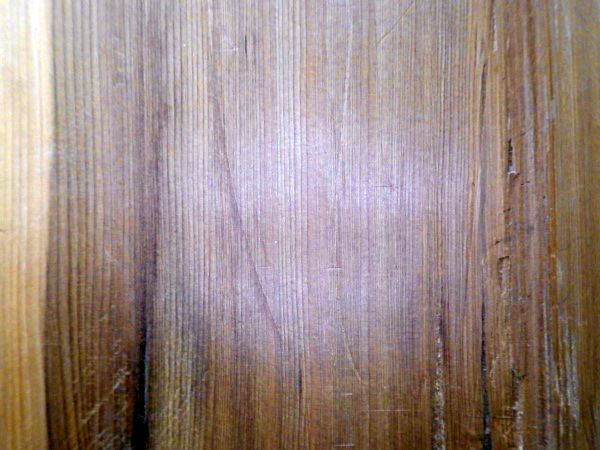
Alnus hirsta_____Betula ermanii__Betula platyphylla_Taxus cuspidatum |
[analytical chemistry (分析化学), cell wall(細胞壁)]
Focusing on the chemical and biochemical aspects of trees and products such as pulp and paper that are derived from treesThree major components
Cellulose (セルロース)The major component of trees → more than 50% of wood (or woody part) for broad-leaved and needle-leaved trees are celluloseRole (in a metaphorical sense): wood = ferroconcrete ⇔ cellulose = rebar  1973 Albersheim: cambium of sycamore (Acer pseudoplatanus)
cultured cell - observed cell wall Fungi (prefering acidic soil), increasing with N concentration ↔ bacteria (neutral pH) cellulose → [cellulase] → glucose, or→ cellobiose (C12H22O11) → [cellobiase] → glucose Aerobic decomposition: dissolved to CO2 = less intermediate productsAnaerobic decomposition: conducted by Clostridium cellobioparus, C. dissolvens, etc. Hemicellulose (ヘミセルロース)
Ex. Cell wall of Avena sativa L. |
Lignin (リグニン)(Broad-leaved tree: 20-25%) < (Needle-leaved tree: 28-31%)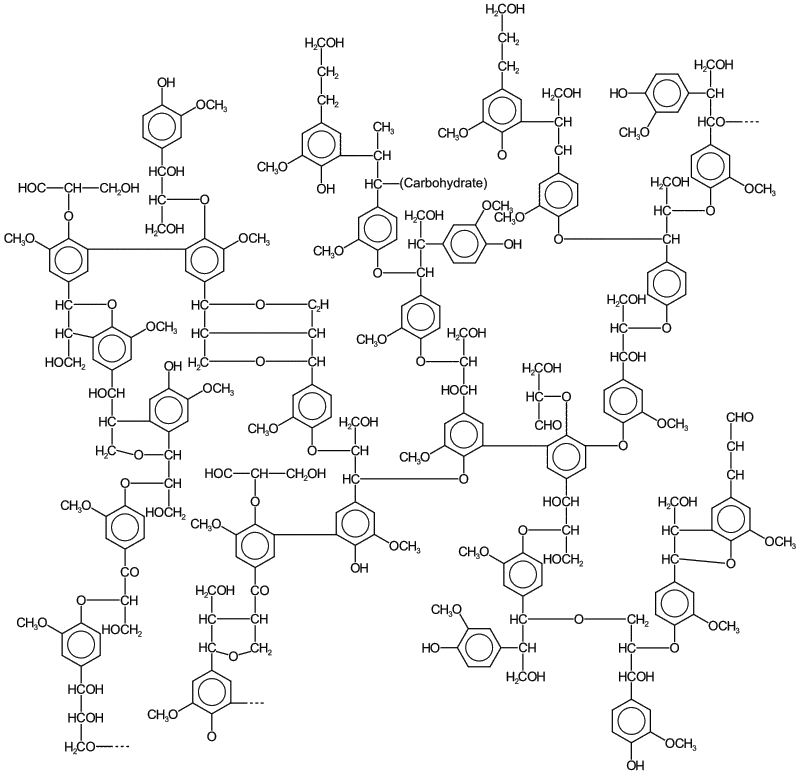 Basic unit: phenylpropane-typed (C6-C3) carbon skeleton → different structural components between species
needle-leaved tree: guaiacylpropane (グワヤシルプロパン)
phenyl-propane (C6-C3) with -OCH3 → vanillin, syringaldehyde, p-hydroxy-benzaldehyde, vanillic acid, etc. Starch (デンプン)☛ structurelow concentration, in particular, in winter |